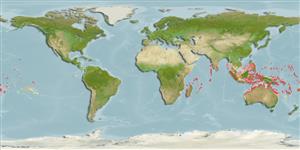>
Blenniiformes (Blennies) >
Blenniidae (Combtooth blennies) > Salariinae
Etymology: Cirripectes: Latin, cirrus = curl fringe + Greek, pektos, -e, -on = made of several parts solidly united (Ref. 45335); stigmaticus: From the Greek word 'stigma' meaninf spot or mark, referring to the body markings.
More on authors: Strasburg & Schultz.
Environment: milieu / climate zone / depth range / distribution range
ນິເວດວິທະຍາ
ສັດທະເລ ກ່ຽວກັນຫີນ; ລະດັບຄວາມເລິກ 0 - 20 m (Ref. 529), usually ? - 10 m (Ref. 90102). Tropical; 15°N - 30°S
Indo-Pacific: Kenya south to Mozambique and throughout the Indian Ocean and western central Pacific to the Marshall and Samoan islands.
Length at first maturity / ຂະໜາດ / ນ້ຳໜັກ / Age
Maturity: Lm ?, range 5 - ? cm
Max length : 10.0 cm SL ຕົວຜູ້/ບໍ່ມີເພດ; (Ref. 529)
ຄີ (ໜາມ)ແຂງຢູ່ຫຼັງປາ (ທັງໝົດ) : 11 - 13; ຄີຫຼັງຂອງປາ (ຄີອ່ອນ) (ທັງໝົດ) : 14 - 16; ຄີ(ໜາມ) ແຂງຢູ່ຄີກົ້ນປາ
ກຸ່ມປາກະດູກແຂງ
ຄວາມຖີ່ຂອງກຸ່ມຖ່າຍທອດພັນ
ປາທີ່ມີການເຄື່ອນຍ້າຍຈາກທະເລໄປຫານ້ຳຈືດ ແລະນ້ຳຈືດຫາທະເລ
ປາທີ່ມີການເຄື່ອນຍ້າຍຈາກທະເລແລະໄປໄຂ່ຢູ່ນ້ຳຈືດ
ຄີກົ້ນຂອງປາ
ສັດທີ່ມີກະດູກສັນຫັຼງ
ການຖ່າຍທອດທາງກຳມະພັນຈາກພໍ່ແມ່ຫາລູກ: 2; ຄີກົ້ນຂອງປາ: 15 - 17; ສັດທີ່ມີກະດູກສັນຫຼັງ: 30 - 32. Diagnosis: Dorsal fin XII, 15, membrane attached to caudal fin, with deep notch above last spine, first spine slightly higher than second; anal fin II, 16; pectoral rays 15; pelvic fin I, 4; caudal fin procurrent rays 10-14. Vertebrae 10 + 21. LL, without scales and scalelike flaps; LL tubes 1-10 (usually 3-8), canal ends below 7th dorsal ray to caudal-fin base. Lower lip smooth mesially, plicate laterally. Upper lip crenulae 35-52. Gill rakers 23-30. Cephalic pore system simple; no pores at extra interorbital position; a pore present behind nuchal flap on each side. Cirri, supraorbital 7-22, nasal 8-29; nuchal 34-47, in 4 groups, ventralmost group borne on slightly expanded nuchal flap on each side. Head and body dark brown with scarlet reticulum anteriorly which becomes spots and wavy lines posteriorly; iris with yellow-ringed pupil. Gilbert Island males are darker; pigmentation on fins brown instead of scarlet; iris are almost entirely yellow (Ref. 529). Large individuals are dark green to black with red spots on the head and red spots to vertical streaks on the sides (Ref. 1602).
Facultative air-breathing in the genus (Ref. 126274); Found solitary or forms small groups in the upper edge of seaward reef slopes, less than 10 m, but may be found up to 20 m deep (Ref. 90102). Adults inhabit coastal reef flats with rich coral and algae habitats (Ref. 48636); also on rocky and coralline structures (Ref. 529); among Acropora and Pocillopora corals of surf-swept algal ridge. Oviparous. Eggs are demersal and adhesive (Ref. 205), and are attached to the substrate via a filamentous, adhesive pad or pedestal (Ref. 94114). Larvae are planktonic, often found in shallow, coastal waters (Ref. 94114).
Life cycle and mating behavior
ການຈະເລີນເຕັມໄວ | ການສືບພັນ | ການວາງໄຂ່ | ໄຂ່ | ຄວາມດົກຂອງໄຂ່ປາ | ຕົວອ່ອນ
Oviparous, distinct pairing (Ref. 205). Urogenital orifice of male genital papilla located basally between 2 widely separated slender filaments on a fleshy swelling behind anus; testes bulbous with length equal its width (Ref. 529).
Williams, J.T., 1988. Revision and phylogenetic relationships of the blenniid fish genus Cirripectes. Indo-Pac. Fish. (17):78 p. (Ref. 529)
IUCN Red List Status (Ref. 130435: Version 2024-2)
Threat to humans
Harmless
Human uses
ການປະມົງ: ທີ່ບໍ່ມີຄວາມສົນໃຈ; ຕູ້ປາ: ເປັນສີນຄ້າ
ເຄື່ອງມື
Special reports
Download XML
ແຫຼ່ງອີນເຕີເນັດ
Estimates based on models
Preferred temperature (Ref.
123201): 25.7 - 29.3, mean 28.5 °C (based on 2222 cells).
Phylogenetic diversity index (Ref.
82804): PD
50 = 0.5000 [Uniqueness, from 0.5 = low to 2.0 = high].
Bayesian length-weight: a=0.01047 (0.00615 - 0.01784), b=3.00 (2.85 - 3.15), in cm total length, based on LWR estimates for this species & (Sub)family-body (Ref.
93245).
ຊັ້ນເຂດຮ້ອນ (Ref.
69278): 2.0 ±0.00 se; based on food items.
ຄວາມຢືດຢຸ່ນ (Ref.
120179): ສູງ, ປະຊາກອນຕຳ່ສຸດທີ່ໃຊ້ເວລາສອງໜ້ອຍກວ່າ 15 ເດືອນ (Preliminary K or Fecundity.).
Fishing Vulnerability (Ref.
59153): Low vulnerability (10 of 100).
Nutrients (Ref.
124155): Calcium = 147 [71, 252] mg/100g; Iron = 0.815 [0.460, 1.440] mg/100g; Protein = 17.8 [16.6, 18.9] %; Omega3 = 0.0843 [, ] g/100g; Selenium = 24.4 [11.3, 56.0] μg/100g; VitaminA = 121 [29, 503] μg/100g; Zinc = 2.59 [1.67, 3.77] mg/100g (wet weight);
